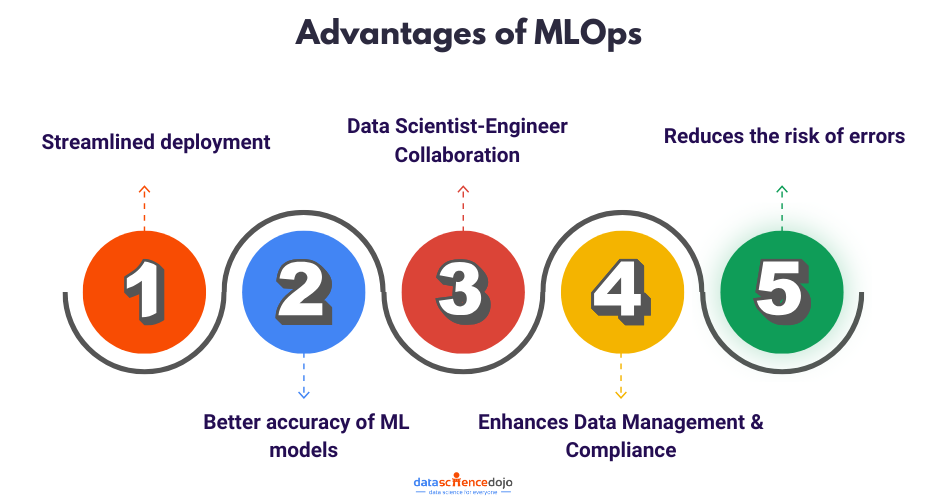Ready to revolutionize machine learning deployment? Look no further than MLOps – the future of ML deployment. Let’s take a step back and dive into the basics of this game-changing concept.
Machine Learning (ML) has become an increasingly valuable tool for businesses and organizations to gain insights and make data-driven decisions. However, deploying and maintaining ML models can be a complex and time-consuming process.
What is MLOps?
MLOps is an evolving field that blends machine learning, DevOps, and data engineering into a unified set of best practices aimed at managing the complete machine learning lifecycle. This includes everything from data ingestion and preprocessing to model training, deployment, monitoring, and retraining.
The inspiration for MLOps comes from DevOps, which revolutionized software engineering by promoting continuous integration, continuous delivery (CI/CD), and automation. In the same way, MLOps seeks to bring structure, scalability, and automation to machine learning workflows, making the process more efficient, reliable, and scalable.
Key Components of MLOps
- Automated Model Building and Deployment: Automated model building and deployment are essential for ensuring that models are accurate and up to date. This can be achieved with tools like continuous integration and deployment (CI/CD) pipelines, which automate the process of building, testing, and deploying models.
- Monitoring and Maintenance: ML models need to be monitored and maintained to ensure they continue to perform well and provide accurate results. This includes monitoring performance metrics, such as accuracy and recall, tracking and fixing bugs, and other issues.
- Data Management: Effective data management is crucial for ML models to work well. This includes ensuring that data is properly labeled and processed, managing data quality, and ensuring that the right data is used for training and testing models.
- Collaboration and Communication: Collaboration and communication between data scientists, engineers, and other stakeholders is essential for successful MLOps. This includes sharing code, documentation, and other information and providing regular updates on the status and performance of models.
- Security and Compliance: ML models must be secure and comply with regulations, such as data privacy laws. This includes implementing secure data storage, and processing, and ensuring that models do not infringe on privacy rights or compromise sensitive information.
Advantages of MLOps in Machine Learning Deployment
The advantages of MLOps (Machine Learning Operations) are numerous and provide significant benefits to organizations that adopt this practice. Here are some of the key advantages:

1. Streamlined deployment: MLOps streamlines the deployment of ML models, making it faster and easier for data scientists and engineers to get their models into production. This helps to speed up the time to market for ML projects, which can have a major impact on an organization’s bottom line.
2. Better accuracy of ML models: MLOps helps to ensure that ML models are reliable and accurate, which is critical for making data-driven decisions. This is achieved through regular monitoring and maintenance of the models and automated tools for building and deploying models.
3. Collaboration boost between data scientists and engineers: MLOps promotes collaboration and communication between data scientists and engineers, which helps to ensure that models are developed and deployed effectively. This also makes it easier for teams to share code, documentation, and other information, which can lead to more efficient and effective development processes.
4. Improves data management and compliance with regulations: MLOps helps to improve data management and ensure compliance with regulations, such as data privacy laws. This includes implementing secure data storage, and processing, and ensuring that models do not infringe on privacy rights or compromise sensitive information.
5. Reduces the risk of errors: MLOps reduces the risk of errors and downtime in ML projects, which can have a major impact on an organization’s reputation and bottom line. This is achieved using automated tools for model building and deployment and through regular monitoring and maintenance of models.
MLOps Lifecycle Stages
The MLOps lifecycle ensures the smooth deployment, monitoring, and continuous improvement of machine learning models. Below are the key stages:
1. Data Ingestion & Validation
This stage focuses on collecting data from various sources and preparing it for model training. It includes:
-
Data Collection: Gathering data from multiple sources such as databases, APIs, or flat files.
-
Data Cleaning: Handling missing values, removing duplicates, and correcting inconsistencies.
-
Data Validation: Ensuring the data meets quality standards and is ready for training.
-
Feature Engineering: Selecting relevant features and transforming data into a usable format.
Quality data is crucial for building accurate models.
2. Model Training & Evaluation
After preparing the data, the model is trained and evaluated:
-
Model Selection: Choosing the appropriate algorithm based on the problem (e.g., classification, regression).
-
Training: The model learns from the training data.
-
Evaluation: The model is tested using metrics like accuracy, precision, recall, or RMSE to assess performance.
-
Cross-Validation: Ensuring the model generalizes well by testing it on multiple subsets of the data.
This stage ensures the model performs well on unseen data.
3. Continuous Integration/Continuous Deployment (CI/CD)
CI/CD pipelines automate the process of integrating and deploying models:
-
Continuous Integration (CI): Automatically testing and merging new code, including model changes, to ensure no breaks in functionality.
-
Model Versioning: Ensuring the right version of the model is deployed to production.
-
Continuous Deployment (CD): Automating the deployment of the model to production, reducing manual intervention and speeding up updates.
This stage promotes efficiency, stability, and faster delivery of model updates.
4. Monitoring & Maintenance
Once the model is in production, it’s crucial to monitor its performance and maintain its effectiveness:
-
Model Monitoring: Tracking model performance over time to ensure it stays accurate.
-
Detecting Drift: Identifying any data or concept drift, where the model’s performance degrades due to changes in data or environment.
-
Retraining: Triggering model retraining when performance declines, often due to drift.
-
Scaling: Ensuring the model can handle increased loads or data volumes.
This stage ensures that models remain reliable and continue to meet business goals.
Best Practices for Implementing MLOps
Best practices for implementing ML Ops (Machine Learning Operations) can help organizations to effectively manage the development, deployment, and maintenance of ML models. Here are some of the key best practices:
- Start with a solid data management strategy: A solid data management strategy is the foundation of MLOps. This includes developing data governance policies, implementing secure data storage and processing, and ensuring that data is accessible and usable by the teams that need it.
- Use automated tools for model building and deployment: Automated tools are critical for streamlining the development and deployment of ML models. This includes tools for model training, testing, and deployment, and for model version control and continuous integration.
- Monitor performance metrics regularly: Regular monitoring of performance metrics is an essential part of MLOps. This includes monitoring model performance, accuracy, stability, tracking resource usage, and other key performance indicators.
- Ensure data privacy and security: MLOps must prioritize data privacy and security, which includes ensuring that data is stored and processed securely and that models do not compromise sensitive information or infringe on privacy rights. This also includes complying with data privacy regulations and standards, such as GDPR (General Data Protection Regulation).
By following these best practices, organizations can effectively implement MLOps and take full advantage of the benefits of ML.
Wrapping Up
MLOps is a critical component of ML projects, as it helps organizations to effectively manage the development, deployment, and maintenance of ML models. By implementing ML Ops best practices, organizations can streamline their ML development and deployment processes, ensure that ML models are reliable and accurate, and reduce the risk of errors and downtime in ML projects.
In conclusion, the importance of MLOps in ML projects cannot be overstated. By prioritizing MLOps, organizations can ensure that they are making the most of the opportunities that ML provides and that they are able to leverage ML to drive growth and competitiveness successfully.





